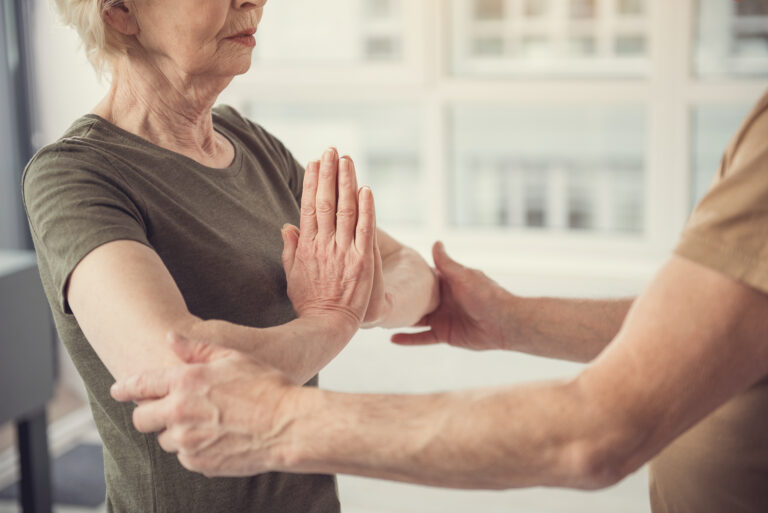Alzheimer’s disease is a progressive brain disorder that affects millions of people worldwide. It is a type of dementia that causes memory loss, confusion, and difficulty with daily tasks. As the disease progresses, it can also affect a person’s ability to move and perform physical activities. This can lead to a sedentary lifestyle and further decline in their overall health.
However, incorporating regular exercise into the daily routine of a person with Alzheimer’s can have numerous benefits. It can improve their physical health, cognitive function, and overall quality of life. But for many caregivers and family members, helping a loved one with Alzheimer’s exercise can be a daunting task. In this article, we will discuss some tips and strategies on how to help a person with Alzheimer’s exercise in a simple and easy-to-understand way.
1. Start Slowly and Gradually Increase Activity
It is essential to start slow and gradually increase the level of activity for a person with Alzheimer’s. Begin with simple movements like stretching or gentle walks around the house. As they become more comfortable with these activities, you can slowly introduce more challenging exercises like chair exercises or light strength training. It is crucial to listen to their body and not push too hard. If they show signs of fatigue or discomfort, take a break or reduce the intensity of the activity.
2. Make it Fun and Engaging
Exercising can be tedious for anyone, let alone for a person with Alzheimer’s. To make it more enjoyable, try to incorporate activities that they enjoy. For example, you can play their favorite music while exercising or involve them in activities like gardening or dancing. Making the exercise session fun and engaging will not only make it more enjoyable but also help them stay motivated.
3. Encourage Independence and Provide Support
Although it may be tempting to do everything for your loved one, it is essential to encourage their independence when it comes to exercise. Allow them to do what they can and provide support when needed. For instance, if they have trouble with balance, you can assist them by holding their hands or standing close by. This will not only help them retain their sense of control but also promote a sense of accomplishment.
4. Be Patient and Understanding
Individuals with Alzheimer’s may have difficulty following instructions or remembering the steps of an exercise routine. It is crucial to be patient and understanding during these moments. If they are having trouble, try breaking down the exercises into smaller, more manageable steps. And always remember to praise and encourage them for their efforts, no matter how small they may seem.
5. Consider Group Activities
Group activities, such as yoga or tai chi classes specifically designed for individuals with Alzheimer’s, can be beneficial. These activities not only provide physical benefits but also offer a sense of community and social interaction that can help improve their overall well-being.
6. Keep Safety in Mind
Safety should always be a top priority when helping a person with Alzheimer’s exercise. Ensure that the environment is safe and free from any hazards. Keep equipment and furniture out of the way, and make sure that the exercise area is well-lit. If your loved one has mobility issues, consider using assistive devices like walkers or handrails to prevent falls.
7. Schedule Exercise at the Right Time
Choose a time of day when your loved one is most alert and energetic to schedule their exercise routine. This could be in the morning or early afternoon, depending on their individual preferences and daily routine. Avoid exercising close to bedtime as it may interrupt their sleep pattern.
8. Stay Consistent
Consistency is key when it comes to exercising for individuals with Alzheimer’s. Set a routine and stick to it to help them develop healthy habits. Regular physical activity can also help improve their sleep patterns, making it easier for them to stick to a schedule.
9. Seek Professional Help
If you are unsure about how to best help your loved one with Alzheimer’s exercise, seek advice from a healthcare professional. They can recommend specific exercises and provide tips on how to make them more accessible for your loved one.
10. Listen to their Needs
Above all, it is crucial to listen to your loved one’s needs and preferences. If they are not enjoying a particular exercise or showing resistance, try to find an alternative that they may enjoy more. Remember, the goal is to improve their physical and mental well-being, and that can only be achieved if they are comfortable and happy with the activities.
In conclusion, regular exercise is crucial for individuals with Alzheimer’s disease. It can not only improve their physical health but also help with managing the symptoms of the disease. By following these simple tips and strategies, you can make exercising a more enjoyable and beneficial experience for your loved one with Alzheimer’s. Remember to be patient, understanding, and always prioritize their safety and comfort.





